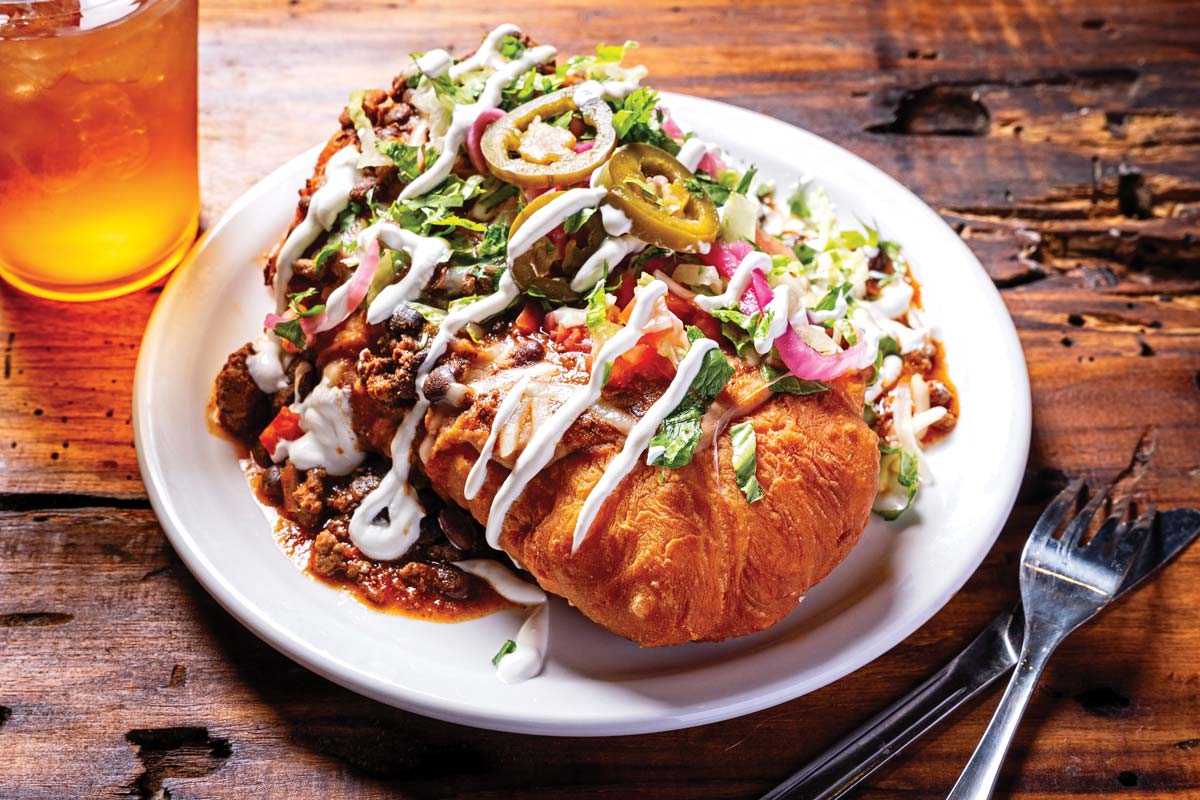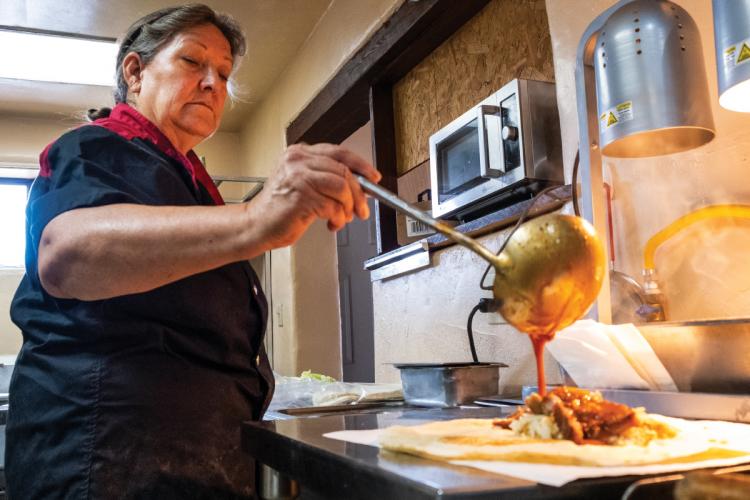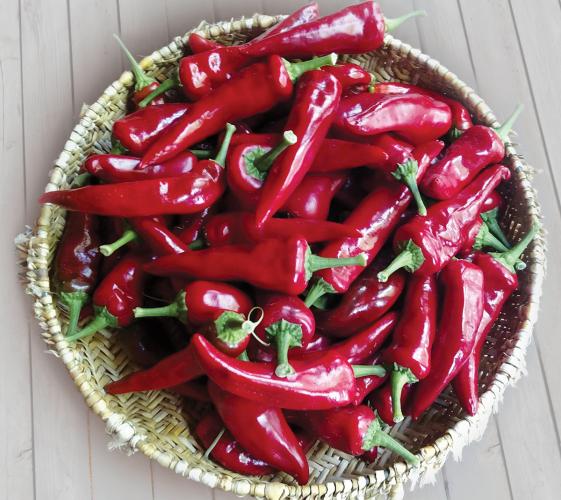In cold weather, many of us turn to a bowl of chili without a thought to its key ingredients: chiles. Yet these potent culinary gifts from the Americas and their recipes reflect generations of Indigenous farmers and cooks who carefully crafted them. Ben and Debbie Sandoval have served up bowls of their “pueblo red chile stew” five days a week for 30 years at their Tiwa Kitchen Restaurant and Bakery, just north of Taos Pueblo in New Mexico. Each steaming bowl contains chunks of pork and the best chiles they can find from local fields. Ben, who is of the Red Willow People of the Taos Pueblo, said, “We only eat what is grown on the pueblo.”
Chile peppers (spelled “chile,” whereas the stew made with them is spelled “chili”) have spiced up Indigenous cuisine up and down the Americas for centuries. The five primary edible species of chiles were first domesticated at least 6,000 years ago in regions from central Mexico to the southern Andes. Archaeologists have found chile starch grain fossils wedged in grinding stones from sites in Ecuador, along with remains of other plants such as maize, manioc, squash, beans and palm—a combination indicating a complex understanding throughout the region of agriculture and cooking.
Unlike other crops eaten for nourishment, chile peppers have had other applications. Although they primarily spice up bland dishes, they also helped to preserve meat. In addition, they have had medicinal applications. The Aztecs, for example, used them to numb toothaches. During the Inca Empire that rose during the 13th century, chiles were so valued they were used as currency.
They also have cultural significance for many Indigenous peoples. According to Paul Bosland, a professor emeritus of plant and environmental sciences at New Mexico State University in Las Cruces, in Meso and South America chiles have been used in ceremonies, including as tributes to or ways to connect with deities.
Wild chile peppers are the size of a pea. The plants have high rates of mutation and crossbreed easily, so farmers began selecting for flavor, color or intensity of heat. Over time, some chiles have lost their heat genes, such as bell peppers. Today, at least 400 varieties of chiles exist.
Roxanne Swentzell, a farmer and sculptor from the Santa Clara Pueblo in New Mexico, is following in the steps of her ancestors. She grows pueblo varieties such as flowering tree chiles that are adapted to a shorter growing season and famous for their sweet, medium-hot taste. Swentzell selects and breeds particular chiles to develop the perfect flavor. She said such careful breeding is “why we have all the varieties we have.”
Chiles spice up food well beyond the Americas, however. Loretta Oden, a Potawatomi chef and food consultant who wrote “Corn Dance: Inspired First American Cuisine,” said, “It’s amazing how widespread they are now and how quickly they spread around the world.”
Columbus encountered chiles on Hispaniola Island in the Greater Antilles during his first voyage in 1492 and mistakenly named them after old world peppers, a completely different species that grows on trees. Portuguese voyagers carried chile peppers from the Americas to Africa and Asia, where they were quickly adopted into local cuisines. Now so many dishes from China, India, Nigeria or Thailand require the fruit—and the heat—of the chile plant that imagining them without this essential ingredient is difficult. Each of these cuisines demands a subtly different combination of heat and flavor from chiles. Mixing varieties allows the cook to create very distinct flavors.
In North America, “New Mexico has the largest plantings of chile crops,” said Ben Sandoval. Chiles are a hot weather plant, which is why they were never cultivated in the American Northeast. As perennials, they can overwinter in warm climates, although an unexpected frost can devastate a crop. Many Native cultures in the Southwest cultivated them in irrigated waffle gardens—small square plots with raised borders to conserve water. Spanish colonists introduced “furrow irrigation,” which brings surface water to crops through trenches. Today, farmers often use drip irrigation to minimize evaporation. Plants are usually started from seed in a greenhouse then transplanted outdoors once the weather warms up. Some farmers also prune the plants midseason to encourage a second crop.
Once harvested, chiles can be used raw or smoked, dried and ground into powders. “We tie our chiles up into ‘ristras,’ chains of peppers 4 to 8 feet long, then hang them up to dry until they turn red,” explained Ben Sandoval. “Then we take the seeds out and save them to plant next year.” A mixture of powdered chiles ultimately seasons his beef, pork or rabbit stews. Chipotle peppers are smoked red jalapeños that impart a distinct pungency to any dish. His stews may include up to 12 different chiles.
The heat in chiles is provided by chemicals called capsaicins. Altogether, there are 22 different kinds of capsaicins, with different proportions in each variety. Each capsaicin locks onto and stimulates receptors in different points, from the lips through the mouth and on to the throat.
When and where chiles are harvested influence their flavor and level of heat. Jalapeños, for example, can be picked green or red. Green chiles are used fresh, after being roasted and peeled; red ones are left longer on the plant to ripen and usually dried and ground into powder. The same variety of a particular chile planted in hot, semiarid regions produces fruits that have higher heat levels than those grown in cooler coastal climates.
“Heat is not just one sensation,” said Bosland, who also co-founded the Chile Pepper Institute at New Mexico State University. “Depending on the variety, it can come on quickly, linger or dissipate. It can feel flat or sharp. There are different kinds of heat profiles culturally.” Asian dishes, for instance, often require a sharp, prickly heat, so U.S. chile growers had to adapt their choice of plants to meet this need.
But chile peppers are more than their heat, write Bosland and his colleague Ivette Guzman: “[C]hile pepper taste is a combination of flavor components and a heat profile that produces a unique sensory experience for each chile pepper variety.” Subtly mixing chiles in different proportions creates an infinite variety of heat and flavors, which allows each cook infinite creativity.
“People usually think of peppers as hot and spicy,” said Alexandra Strong, who has Taíno heritage and serves as executive chef at the National Museum of the American Indian’s Mitsitam Native Foods Cafe. “But some are more smoky and flavorful.” Growing up, she learned to cook from her mother and grandmother using aji dulce and cubanelle peppers, ground with a mortar and pestle, a combination more sweet and aromatic than spicy. She leans more toward New Mexico flavors at Mitsitam, using ancho chiles for their subtle kick and guajillos for their smoky touch, she said.
People are once again looking to the other potential powers of chiles. For instance, they contain vitamin C, and Strong’s grandmother steeped peppers into a tea to treat colds. Chinese researchers say eating chile peppers may even help people lose weight by burning fat, suppressing appetite or affecting the gut and the bacteria that live there. Or maybe, Oden suggested, “the food just gets too hot to eat.”

Photo by George Conomos/Restaurant Associates
Buffalo Chili
This Indian taco made with chili on top of frybread is a favorite at the Mitsitam Native Foods Cafe. The following recipe is from the “Mitsitam Cafe Cookbook,” which features a a range of Indigenous dishes from across the Western Hemisphere.
2 tablespoons of canola oil
1 pound ground buffalo meat
1 yellow onion, chopped
1 green bell pepper, chopped
2 chipotle chiles en adobo, minced
1 to 2 tablespoons of ground coriander
1/4 cup chile powder
1 tablespoon minced garlic
1 28-ounce can diced tomatoes
1 cup tomato puree
2 cups cooked pinto beans, drained or canned pinto beans, drained and rinsed
1 cup water
1 cup beef stock
2 tablespoons tomato paste
1/2 cup masa harina
Salt and freshly ground black pepper
In a Dutch oven or heavy soup pot, heat the oil and cook the ground buffalo over medium heat, breaking it up with a spoon until well browned and crumbled. Add the onion, bell pepper, chiles, cumin, coriander, chile powder and garlic. Sauté until the onion is translucent, about 3 minutes.
Stir in the tomatoes and tomato puree; bring to a simmer and cook for 15 minutes. Add the pinto beans, water and beef stock. Bring to a boil over high heat then reduce the heat to a simmer and cook for 30 minutes. Stir in the tomato paste and simmer 30 minutes more. Gradually stir in the masa harina to thicken lightly. Add more water or stock if the chili becomes too thick. Season with salt and pepper. Simmer for 15 minutes.
Published by the National Museum of the American Indian in association with Fulcrum Publishing. © 2010 Smithsonian Institution


